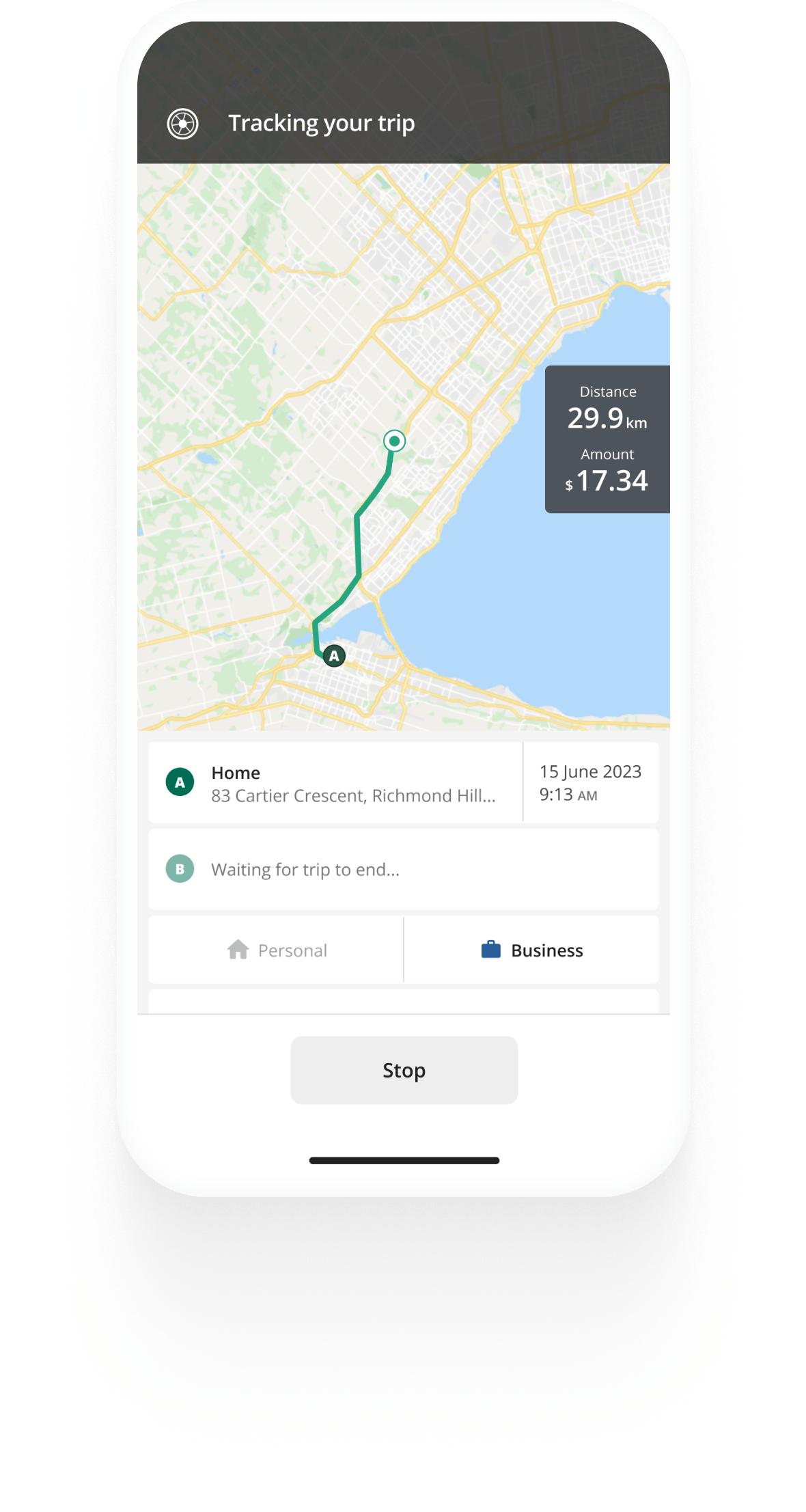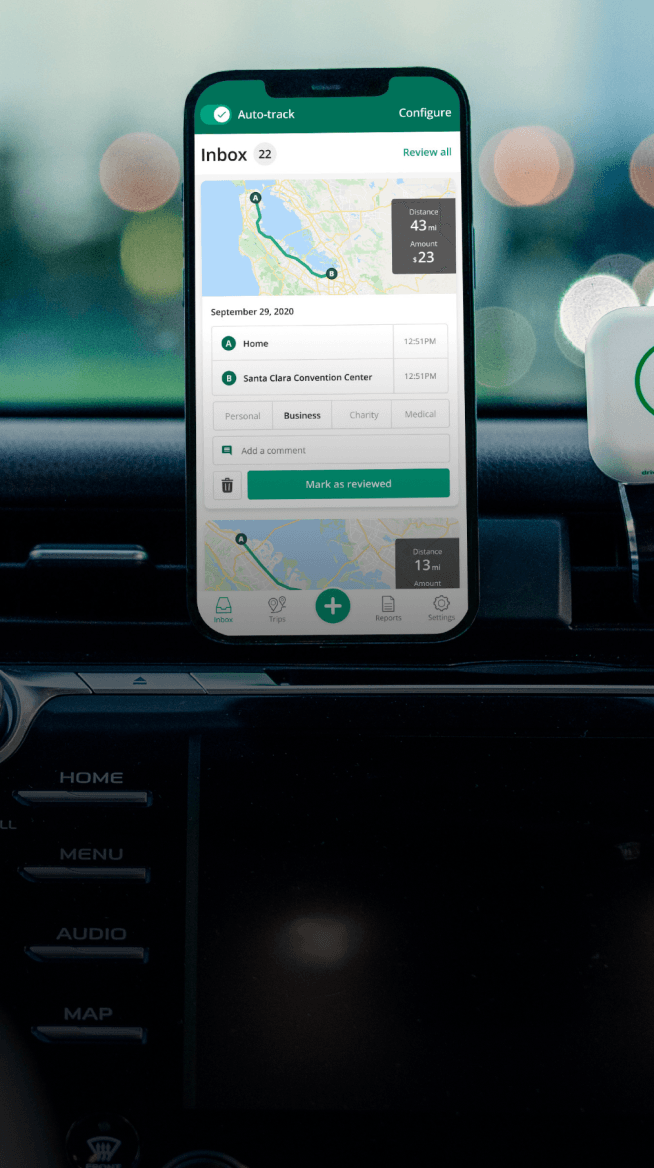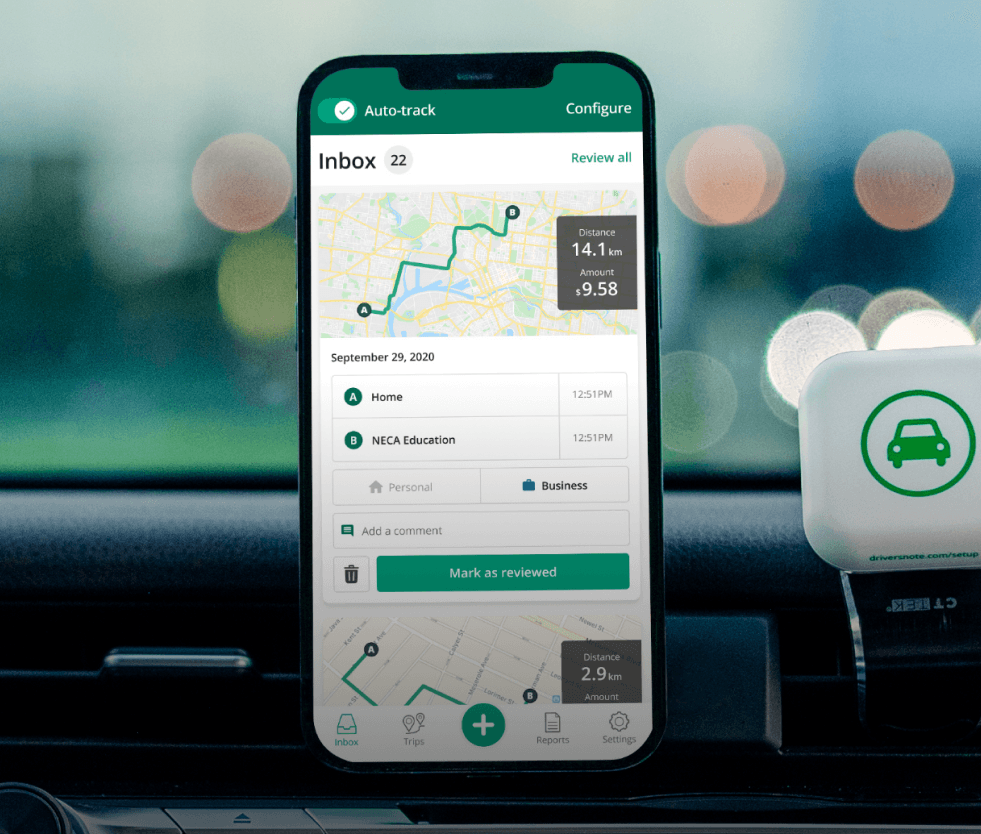Track mileage automatically
Get started.svg)
Capital Cost Allowance for Vehicles
In this article
- This is how CCA is calculated for a vehicle
- Eligibility criteria for claiming car capital cost allowance
- Different CCA classes covering vehicles
- Accelerated Investment Incentive
- Half-year rule
- CCA class 10 vs 10.1
- Short-taxation year
- Claiming a Capital Cost Allowance deduction for your vehicle
- Claiming vehicle CCA as an employee
- FAQ
- This is how CCA is calculated for a vehicle
- Eligibility criteria for claiming car capital cost allowance
- Different CCA classes covering vehicles
- Accelerated Investment Incentive
- Half-year rule
- CCA class 10 vs 10.1
- Short-taxation year
- Claiming a Capital Cost Allowance deduction for your vehicle
- Claiming vehicle CCA as an employee
- FAQ
In Canada, capital cost allowance (CCA) is a tax deduction that self-employed and business owners can claim on depreciable capital assets used for business purposes.
You can claim CCA on a broad range of assets. This article focuses on CCA for vehicles and CCA classes that are relevant to them.
Vehicles are depreciated at different rates depending on their type, purpose, date of acquisition, etc. Read on to learn what you need.
This is how CCA is calculated for a vehicle
Vehicle depreciation is calculated by using the applicable CCA rate on the total capital costs, including taxes, delivery costs, legal costs, and freight charges of the asset. The amount of CCA claimed in a year decreases the balance of the CCA class, referred to as undepreciated capital cost (UCC).
Example of how to calculate CCA
If you buy a car for $25,000 and the applicable CCA rate is 30%, your CCA for the first year is $7,500 ($25,000 * 30%).
Calculating UCC on a vehicle
In the example above, the UCC balance at the end of the first year is $17,500 ($25,000 - $7,500).
This ending balance of $17,500 will then be your opening UCC balance for the following year.
You would use $17,500 as a base figure for calculating a CCA of $5,250 for the second year. For the asset’s third year, the UCC balance would be $12,250 ($17,500 - ($17,500 * 30%).
This process continues until your car’s value is completely written off.
The CCA you can claim on assets is proportional to their business use. If your car is driven 50% for personal and 50% for business use, you can only claim CCA on the portion used for business activities.


Track business driving with ease
Trusted by millions of drivers
Automate your logbook Automate your logbook

Automatic mileage tracking and CRA-compliant reporting.
Get started for free Get started for freeEligibility criteria for claiming car capital cost allowance
You can generally claim CCA on your car when it becomes available to you, which is the earlier of:
- The date you first used your vehicle to generate business or property income.
- The second taxation or fiscal year following the year when you purchased the asset.
Motor vehicles, passenger vehicles, trailers, trucks, and buses are deemed available for use when you’ve obtained any required licenses, permits, or certificates to operate the vehicle successfully.
Different CCA classes covering vehicles
No all vehicles can be depreciated at the same rate. The following table exhibits the rates you need to use when calculating CCA on a vehicle and the eligibility criteria for different CCA classes:
|
CCA class |
Rate |
Vehicles covered by the class |
|
CCA class 10 |
30% |
Motor vehicles and passenger vehicles as defined by the CRA. This includes regular cars, pick-up trucks, sports cars, etc. Automotive equipment, such as delivery vans that cost up to $30,000 (excluding GST/HST or PST) |
|
CCA class 10.1 |
30% |
1) Passenger vehicles purchased between 2001 and 2021 that cost over $30,000 (excluding GST/HST or PST) 2) Passenger vehicles purchased in 2022 that cost over $34,000 (excluding GST/HST or PST) 3) Passenger vehicles purchased in 2023 that cost over $36,000 (excluding GST/HST or PST) 4) Passenger vehicles purchased in 2024 that cost over $37,000 (excluding GST/HST or PST) 5) Passenger vehicles purchased in 2025 that cost over $38,000 (excluding GST/HST or PST) Scroll down to find additional information about CCA class 10 vs 10.1. |
|
CCA class 16 |
40% |
Taxis, vehicles used in a car rental business, and freight trucks acquired after December 6, 1991, and weighing over 11,788 kg |
|
CCA class 54 |
30% |
Zero-emission vehicles (ZEVs). This category includes motor and passenger vehicles but excludes taxis and vehicles used for rent or lease |
|
CCA class 55 |
40% |
Zero-emission vehicles, including taxis and vehicles used for rent or lease |
|
CCA class 56 |
30% |
Zero-emission automotive equipment (such as aircraft, watercraft, railway, and trolley buses) that cannot be used on roads and are acquired and used after March 1, 2020, and before 2028 |
Additional information on class 54, 55 and 56:
Under Classes 54 and 55, zero-emission vehicles that meet all the following conditions may qualify for a 100% deduction in the first year.
- The vehicle was acquired after March 18, 2019, and was available for use before 2028
- It’s either fully electric, hydrogen-powered, or a plug-in hybrid with a battery capacity of a minimum of 7kWh
- The vehicle hasn’t been used before being acquired
- No CCA deductions or terminal loss deductions were claimed in the past
- No assistance has been provided by the Government of Canada under the new scheme launched on March 19, 2019
For zero-emission passenger vehicles under Class 54, you can claim the enhanced capital cost allowance deduction in the first year. This is up to $55,000 for vehicles acquired between 2019 and 2021, $59,000 for those acquired in 2022, and $61,000 plus sales tax for those acquired from 2023 through to the end of 2025.
For both Classes 54 and 55, you can claim enhanced CCA deduction in the first year as follows:
- 100% on vehicles acquired after March 18, 2019, and before 2024
- 75% on vehicles acquired in 2024 and 2025
- 55% on vehicles acquired in 2026 and 2027
Vehicles or equipment that are fully automotive and electric are eligible for the enhanced first-year allowance under Class 56. Similar to classes 54 and 55, this enhanced deduction is in the phase-out period, and the CCA rates are based on the year in which you acquired the vehicle:
- 100% on eligible vehicles acquired on or after March 2, 2020, and before 2024
- 75% on vehicles acquired in 2024 and 2025
- 55% on vehicles acquired in 2026 and 2027
Accelerated Investment Incentive
The Accelerated Investment Incentive (AII) rule allows you to claim more CCA in the first year of acquiring an eligible depreciable asset. It allows you to claim more deductions than usual.
This rule cannot be used on class 54, 55, or 56 vehicles.
Eligibility criteria for AII
Your vehicle can be eligible for AII if it meets the following criteria:
- You acquired it after November 20, 2018, and it was made available for use before 2028
- No CCA has previously been claimed on the asset
There are a few additional conditions you should be aware of to apply AII on depreciable assets, including vehicles:
- The half-year rule, which allows you to claim a 50% deduction on buying an eligible asset in the first year, is suspended from 2018 to 2027.
- The half-year rule can’t be used simultaneously with AII.
- The amount of assets purchased (additions) in a year exceeds the amount received from the asset’s sale (referred to as disposals, which is the lesser of the a) vehicle’s original cost, b) net amount received from the sale).
Under the AII rule, the amount of net additions (additions minus disposals) is multiplied by one-half. The total amount of UCC balance (if any), net additions, and half of net additions are used as a base amount to calculate CCA for the first year.
Calculating the Accelerated Investment Incentive
The accelerated investment incentive helps you claim a higher capital cost allowance deduction in the year you buy a vehicle. If you meet the above conditions, you can claim 1.5 times the normal CCA amount using AII.
For example, if you bought a Class 10 vehicle for $5,000 in 2021, which is eligible for the AII rule, your first-year CCA deduction will be:
($5,000 + ($5,000 * ½)) * 30% = $2,250, which is 1.5 times the normal CCA of $1,500 ($5,000 * 30%)
The ending UCC balance for the first year will be $2,750 ($5,000 - $2,250).
Carry forward the ending UCC to the next year, and multiply the CCA rate by the UCC balance: $2,750 * 30% = $825.
This results in the ending balance of $1,925 for the second year ($2,750 - $825).
Half-year rule
The half-year rule allows you to claim 50% of CCA on the net additions of eligible assets for the year. The idea is to prevent people from claiming a full deduction on an asset, even if they buy it near the end of the year.
Under the half-year rule, 50% of the net additions are subtracted to calculate the base amount for CCA. However, some vehicle classes are excluded, including 54, 55, and 56.
The adjusted UCC balance in the first year (on which the CCA rate is applied) is calculated as:
Opening UCC balance + net additions - 50% of the net additions.
Apply the relevant CCA rate on the adjusted UCC balance. The ending UCC (or the opening UCC in the following year) will be: adjusted UCC balance - CCA + 50% of net additions (calculated above)
The CCA deduction for the second year will be the applicable rate * opening UCC for the second year (assuming no other asset was bought or sold).
CCA class 10 vs 10.1
As described in the table above, Class 10 includes motor vehicles, delivery vans, and passenger vehicles, which cost up to $30,000, while Class 10.1 includes more expensive passenger vehicles. See the table for specifics.
Though both classes have the same CCA rate, a few rules differentiate them from each other:
- You can group all of your eligible vehicles under Class 10. However, for class 10.1, you must report each vehicle separately under class 10.1.
- There’s no maximum capital cost applicable for Class 10 assets. However, the maximum capital cost for Class 10.1 varies based on the vehicle's acquisition date. For example, if you bought a passenger vehicle for $35,500 in 2022, its capital cost under Class 10.1 would be $34,000 plus applicable provincial taxes. However, if you bought a Class 10 vehicle at $25,000, its capital cost would be $25,000 plus applicable provincial taxes.
- The half-year rule doesn’t apply to class 10 when a vehicle is sold. However, you can apply it to Class 10.1.
- If the UCC balance becomes negative after you sold or traded in a vehicle under class 10, and there are no assets remaining in the class, you can apply recapture (added to your income for tax purposes) to bring the negative balance to zero. However, the recapture rule can’t be used for vehicles sold or traded under Class 10.1.
Modified Accelerated Investment Incentive
AII was introduced as a temporary measure to encourage businesses to invest more in capital assets. It’s currently being phased out, and a modified AII rule will be in effect for vehicles used from 2024 to the end of 2027.
For assets not generally subject to the half-year rule that are acquired and used during the phase-out period, AII will be applied at 1.25 times net additions rather than 1.5 times, as calculated above.
Short-taxation year
When a business's fiscal year is less than 12 months, it’s called a short-taxation year. The rule is to prorate the number of days in the fiscal period and apply the applicable rate on the vehicle's capital cost. If the AII rule is relevant, include it in your calculation to claim a higher CCA deduction.
Example of a short taxation year:
Your business was incorporated on July 1, 2021, with a December 31 year end. On July 30, 2021, you purchased a motor vehicle costing $10,000 for business use.
In this case, you calculate CCA from July 1, 2021 to December 31, 2021. The calculation will be: ($10,000 + ($10,000 * 0.5)) * 30% * 184/365. This results in a capital cost allowance of $2,268.50.
Claiming a Capital Cost Allowance deduction for your vehicle
You can claim CCA on the asset’s undepreciated capital cost (UCC) balance remaining in the asset class. The UCC balance is simply the amount that hasn’t yet been depreciated, and you can use this amount to calculate your capital cost allowance.
You can claim CCA anywhere from zero to the maximum amount in a given year, depending on income, asset type and applicable rate. If you have income tax payable for the year, you may want to use the maximum CCA amount to maximize your deductions and ultimately pay lower taxes on your business or property income.
Enter the relevant amounts in Area A (Calculation of Capital Cost Allowance Claim) on the form T2125 (Statement of Business or Professional Activities) to find out how much CCA you can claim in a given year. Attach this form when filing your income tax return.
Claiming vehicle CCA as an employee
If you are a salaried or a commission-based employee, you may be able to claim a vehicle capital cost allowance.
As a salaried employee, you need to meet all the following conditions:
- You were required to work away from your regular place of work
- You paid your own vehicle-related expenses.
- You didn’t receive a non-taxable reimbursement for your vehicle expenses from your workplace
- You have a copy of a completed and signed by your employer Declaration of Conditions of Employment (form T2200)
As a commission employee, you must meet the same conditions as above, as well as:
- According to your employment contract, you cover your own expenses
- You were renumerated in whole or in part by a commission or similar amount
What these conditions mean for you is that if your employer reimburses you for your business-related driving expenses, you cannot claim vehicle CCA. If you are eligible for the claim, use form T777 - Statement of Employment Expenses.
Note that you can claim a percentage of CCA that corresponds to the percentage of your business-related driving. If, for example, 40% of your recorded kilometres during the year were for business purposes, you will be able to claim 40% of the calculated vehicle CCA.
FAQ

Tired of logging mileage by hand?
Effortless. CRA-compliant. Liberating.
Top posts
- Mileage Calculator Canada
- Self-Employed Tax Deductions you Should Claim in Canada
- Free CRA Mileage Log Template
Related posts
CRA Mileage Rate 2024
Latest update: February 20, 2024 - 2 min read
The CRA announces 2024 rates for vehicle allowance: From January 1st, 2024, per kilometre rates will increase 2 cents over 2023.
Mileage Calculator Canada
Latest update: October 27, 2025 - 2 min read
Choose a CRA per-kilometre rate or enter your own. Simply enter how many km you drove to calculate your allowance or deduction.
Self-Employed Tax Deductions you Should Claim in Canada
Latest update: October 22, 2025 - 2 min read
See a list of common tax deductions for self-employed individuals in Canada and how to claim them at tax time to maximize your tax savings.


.svg)